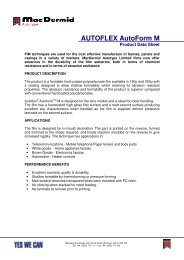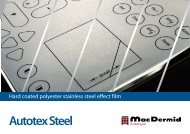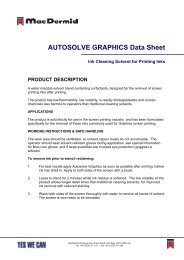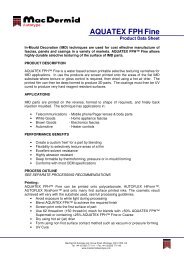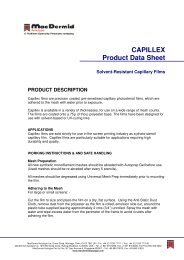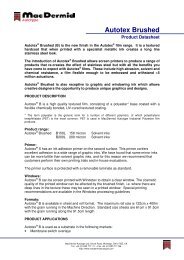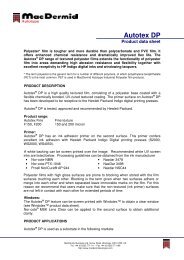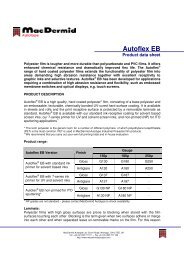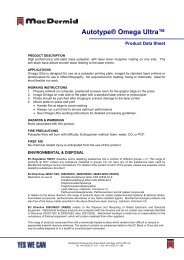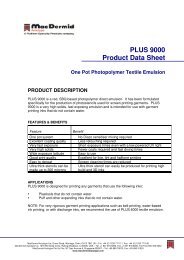Screen E-Book (.PDF) - MacDermid Autotype
Screen E-Book (.PDF) - MacDermid Autotype
Screen E-Book (.PDF) - MacDermid Autotype
- No tags were found...
You also want an ePaper? Increase the reach of your titles
YUMPU automatically turns print PDFs into web optimized ePapers that Google loves.
grey, the Lab values of the printed and referencegreys were measured (you need aspectrophotometer or spectrodensitometerfor this, but all serious colour printersshould have these) and the colour difference(DeltaE) calculated. The DeltaE’s forthe three greys were then summed andput on a 0 100% scale with the averagevalue ~50 and defined so that perfectgreys (i.e. a DeltaE sum of 0) gave 100%.For the 3-colour tones the most satisfactorymethod turned out to be a simple measureof the %K along a 0 100% 3-colourtone strip followed by adding together thedifference between the measured %K andthe specified value. Again the results wereput on a 0 100% scale with the averageset at 50 and perfection defined as 100%.Because the shadows are so importantfor a good print, and because the Caza bsequence showed a clear advantage overthe other prints (there is no dot-on-dotshadow gain when the K is printed first) wewanted to do the same sort of measure aswith the 3-colour tones. Unfortunately ourprinted 4-colour strip was a pure theoreticalstrip with no GCR/UCA. It showed enormousdot-gain, making the measurementtechnique unsatisfactory. We reluctantlyresorted to an expert relative assessmentof the degree of shadow clarity (using theproof as a reference standard) and to beconsistent with the other measures gavethe prints a score either side of 50 with ascatter similar to the other measures.So we were able to provide numbers forthree values. To calculate the CFI we addedthe three values then divided by threeto get their average. For example, Seq 1had values of 31, 60, 48 which gave a totalof 139. Divide that by 3, gives 46.15° moiréOur subjective judgements of the printquality was greatly affected by the fact thatprints 1, 3 and 7 had terrible moiré visible inthe pretty lily. The reason quickly becameclear. In each case we were printing a lightM tint on top of a relatively solid Y. Thisisn’t entirely obvious because sequence 3is YCMK; but the lily has almost no C so theM was going directly on top of the Y. Thenext fact to check was the screen angles.The Y and M are indeed 15° apart. Youwould not expect any moiré from Y and Cas they are 45° apart, and there isn’t muchK on Y printing. Why were we seeing moiréonly in M on Y? The important answer isthat we weren’t! In the 4 image prints, ithappened that only the lily was set up toshow the moiré. In the 2-colour test stripsthere was very strong moiré of both M onY and Y on M in the middle tones.As explained in Steve’s moiré section ofthe e<strong>Book</strong>, moiré depends on three factors.The first is the maths, the second isthe human eye, the third is amplification ofthe mathematical effect. Mathematically15° moiré is always present. But generallythe human eye accepts it if its amplitudeis below a certain level. What happens57



